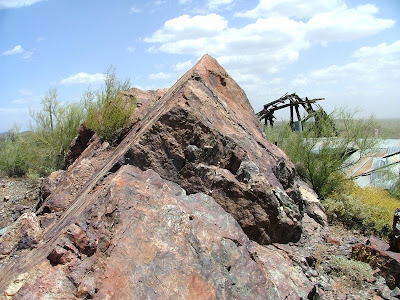Quartz is considered to be second most common mineral in the earth's crust, after feldspar. To be honest, I'm not sure who actually measured all of the quartz deposits and compared them to feldspar occurrences to come up with this conclusion. But, I suspect minerals such as calcite, gypsum, mica are not far behind feldspar and quartz in the most voluminous minerals in the crust.
If you have ever walked along a beach, drove over sand dunes in a desert, or spent time hiking through basins filled with sandstones, greywackes, and quartzites, you will likely agree that quartz is common. Quartz is silicon-dioxide and comes in a variety of habits including crystalline quartz, chalcedony, agate, jasper, amethyst, citrine, smoky quartz, and rose quartz.
 |
| Quartz stockworks in silicified rhyolite. Many narrow quartz veinlets fill fractures in the rhyolite host rock at the Commonwealth mine, Arizona. |
Quartz comes in a variety of colors and some may contain vugs filled with hexagonal, quartz crystals, other may contain drusy quartz (tiny, fine-grained, quartz crystals), or occur as massive layers without any distinct crystals. And periodically, one may come across crystals of quartz that replaced other minerals such as jade, or even jade that replaced quartz.
.JPG) |
| Prismatic quartz (tiny crystals) with banded quartz, Commonwealth mine, Arizona. |
.JPG) |
| Ginguro bands in banded quartz vein, Commonwealth mine, Arizona. |
 |
| A ribbon vein in mine back (ceiling) cutting other near-horizontal veins, Giant King, California. |
 |
| Large milky quartz vein in mine back, California. |
%20copy.jpg) |
| Shear zone filled with gold-bearing quartz veins, Carissa mine, South Pass. Wyoming. |
 |
| Narrow off-set, gold-bearing quartz vein in tonalite, Mary Ellen mine, South Pass, Wyoming. |
 |
| 45-degree, dipping, iron-stained quartz vein, Vulture mine, Arizona. |
.%20AMAX%20sample%20photographed%20by%20D.%20Hausel%20(gemhunter.webs.com).JPG) |
| Silver-rich quartz vein grab sample, Oregon vein, Kirwin, Wyoming. |
%20copy.JPG)